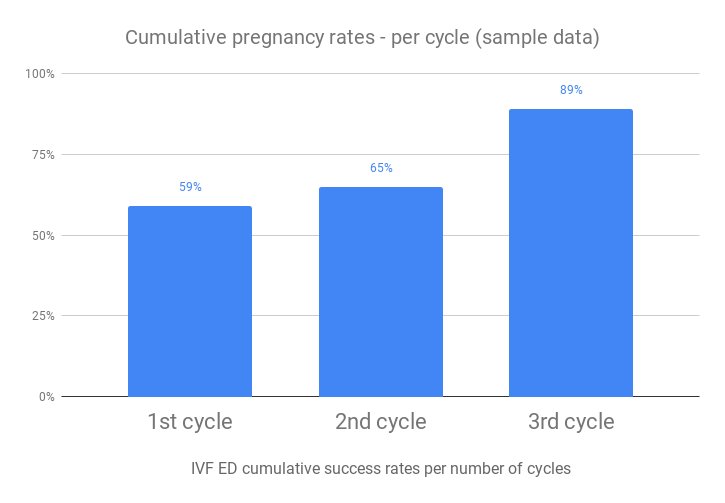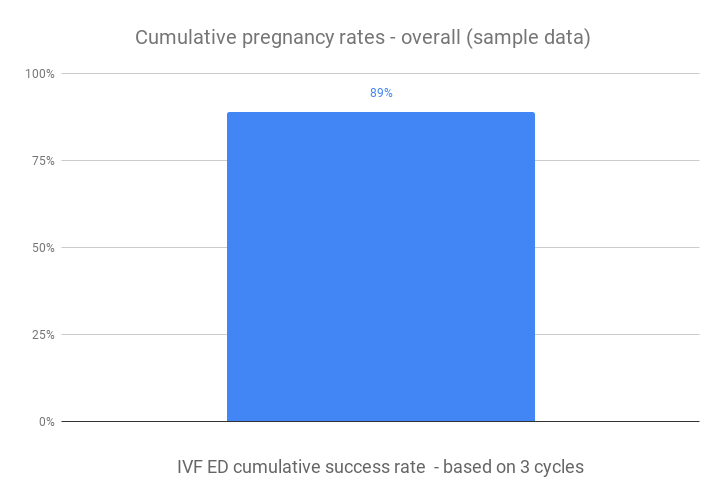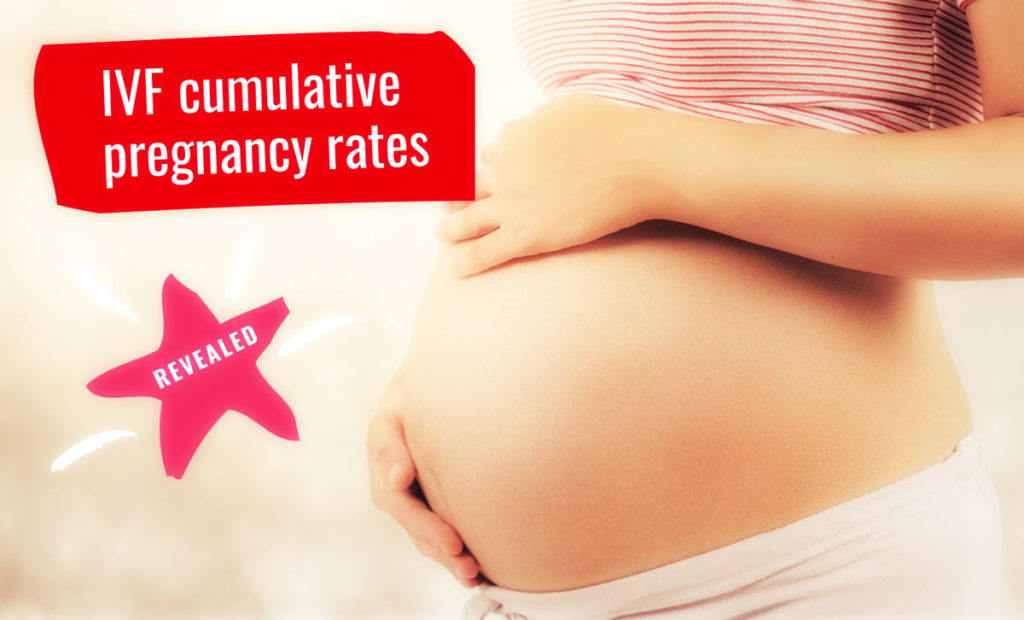Table of Contents
- 1 Cumulative IVF success rate / cumulative live birth rates – the higher the better
- 1.1 Ways of presenting the cumulative pregnancy success rates
- 1.2 Why do clinics increasingly often show success rates as a cumulative indicator of getting pregnant or having a baby?
- 1.3 Is it really true that by performing several IVF programmes you can get a much higher success rate compared to a single in vitro program?
- 1.4 Live birth vs. pregnancy rates
- 1.5 What’s the idea behind the cumulative IVF success rates? Is it just marketing? Where did the idea come from to show the cumulative IVF effectiveness instead of the effectiveness per single cycle?
- 1.6 Why do most clinics decide not to show the statistics of cumulative IVF success rates?
- 1.7 If you need help choosing an IVF Clinic Abroad Spare 3 minutes of your time. You will save at least a few hours.
What is the cumulative IVF success rate?
Cumulative IVF success rates/cumulative live birth rates usually reflect the average effectiveness of treatment, not per IVF cycle, but taking into account a few cycles, usually 3-4. Sometimes cumulative pregnancy rates can include, apart from full IVF cycles, frozen embryo transfers. You should pay attention to the way this data is presented and ask the clinic about their method of measuring these rates. Cumulative IVF statistics can be measured using various methods. Usually, fertility clinics do not disclose what exactly was taken into account when creating the statistics. From your perspective, the perspective of a patient, such information may be crucial.
OPTION 1
Cumulative pregnancy success rates can be calculated per number of full IVF cycles for a specific patient, for example, a patient who has had three IVF cycles or a patient who has had two IVF cycles or four IVF cycles. The number of cycles is usually stated.
OPTION 2
Cumulative pregnancy success rates can also be calculated taking into account frozen embryo transfers, i.e. a patient has had two full IVF cycles but her third cycle was only the transfer of frozen embryos acquired during the previous two cycles. When clinics show their cumulative success rates, they may show this as three IVF cycles.
Cumulative IVF success rate / cumulative live birth rates – the higher the better
Most patients, when selecting an IVF clinic, ask about success rates upfront. In one of our articles, IVF with donor egg success rates, we explain what you should pay attention to when analysing data presented by clinics. The article talks specifically about success rates and the various ways clinics present statistics.
However, when it comes to IVF success rates, clinics are starting to provide cumulative statistics rather than per cycle.
Ways of presenting the cumulative pregnancy success rates
Most often IVF clinics use 2 ways of presenting cumulative statistics of treatment:
Some clinics show success rates calculated for each IVF cycle of a given patient – that is, if the statistics are based on three cycles, the graph will consist of three bars, each signifying a patient with a specific number of performed IVF cycles (fig. 1). The graph below shows that 59% of patients get pregnant after the first cycle, 65% after the second cycle and 89% after the third IVF cycle.

However, there are some clinics that do not show the cumulative success rates for each patient group, but show one number that refers to, for example, three IVF cycles (fig. 2). With this presentation of results, you cannot read what percentage of patients get pregnant during the first, second or third in vitro program. The following example shows that 89% of patients get pregnant after three IVF cycles.

Important: the charts have been prepared for educational purposes only and do not show data presented by any of the IVF clinics. Any similarity in the scope of the presented data is accidental.
The phrase “the patient gets pregnant” may not mean what you think it means. What do clinics actually mean by “pregnancy” here? The answer to this question can be found here in the article on IVF success rates.
Why do clinics increasingly often show success rates as a cumulative indicator of getting pregnant or having a baby?
The answer to this question seems to be simple – the higher the treatment success rates presented on a clinic’s website, the easier it is to convince the patient that they should choose that particular clinic. Cumulative data looks better. It is for this reason that some clinics present the results of treatment in such a way. The examples below show entirely different data:
Clinic 1: IVF success rates: 47%
Clinic 2: Cumulative IVF Success Rates: 62%
However, a patient usually will remember only the percentage values and subconsciously recognises that the higher value is better.
Although everything depends on the way the data is presented, whether the clinic presents cumulative success rates for each of the three IVF cycles or whether they provide only general information with a single percentage value.
Is it really true that by performing several IVF programmes you can get a much higher success rate compared to a single in vitro program?
It is indeed true. Cumulative success rates in good IVF centres that have the appropriate experience and know-how can be very high. According to a study published in the New England Journal of Medicine, for older female patients, live birth rates can be considerably improved with continued treatment using donor eggs, which, certainly, remains a personal decision for women. Below you will find average values for the cumulative success rates of IVF treatment.
1. Cumulative pregnancy rate / Cumulative live birth rate – IVF with own eggs
In the case of IVF programmes with own oocytes, cumulative success rates can be on average 25% to even 70% – taking into account three IVF cycles carried out in a short period of time. The discrepancy is very large because the age of a woman is very important in the case of an in vitro programme with own eggs: the older the patient the lower the effectiveness of treatment. According to a study, success rates decline with increasing age for female patients using their own eggs, especially for those aged 38 years and older, but not for women undergoing egg donation programme. It is assumed that for women aged 40-42, with a single IVF cycle with own eggs, the success rates can be, on average, 4-11%.
2. Cumulative pregnancy rate / Cumulative live birth rate – IVF with donor eggs
In the case of IVF with donor eggs, cumulative success rates can be on average 75% to even 95% – taking into account three IVF cycles with donor oocytes – performed in short time intervals. Of course, the average success rate with a single programme will be lower. On average, this type of treatment will have 55-65% success rates depending on the clinic and depends on woman’s age in a very limited way.
Live birth vs. pregnancy rates
We have already published an article about the ways IVF clinics present success rates statistics and the difference between live birth and pregnancy rates for in vitro programmes in the article on IVF success rates. In that article, you will also find an explanation of how you can calculate your live birth success rate. If you have pregnancy success rate data, you can use the tool we developed, Pregnancy Funnel, to find out what your chances of a live birth are.
What’s the idea behind the cumulative IVF success rates? Is it just marketing? Where did the idea come from to show the cumulative IVF effectiveness instead of the effectiveness per single cycle?
The very idea of a cumulative approach to the effectiveness of IVF is completely different from just showing the highest values on the chart and has a substantive and psychological justification.
Infertility treatment using in vitro fertilisation techniques is a complex and often lengthy process, both medically and diagnostically. Lack of implantation or miscarriage might happen on the way and they are certainly highly emotional and overwhelming experiences for all patients. However, it is believed that the failures of in vitro programmes should be considered to aid subsequent IVF attempts. It is also believed that conducting a further in vitro programme may have therapeutic significance to the patient. Statistically, the highest chances are obtained with the third IVF cycle. There are many factors that determine this: during the subsequent cycles doctors will have a fuller picture of your case and will be able to use their knowledge of your previous failures to your advantage. They will know how you respond to drugs or your ability to prepare the uterus for transfer.
The most important element, however, is the way in which the clinic conducts the patient’s treatment. Do the doctors use the knowledge they have? Is every patient and their every IVF attempt treated in exactly the same, routine way? Does the clinic operate like a “factory” or does it offer personalised treatment depending on the individual situation of the patient?
Why do most clinics decide not to show the statistics of cumulative IVF success rates?
Some clinics simply cannot provide such data because its acquisition and processing can be technically complicated.
On the other hand, patients often look at treatment from a financial perspective. If they see cumulative data (based on several IVF cycles), they may perceive the clinic as very expensive. They may think that the clinic tries to deceive patients and sell them a minimum of three cycles to show that it is the third one that is the most effective.
85% of patients who begin IVF treatment believe that they will get pregnant in their first IVF cycle and when they calculate their budget, they usually consider the cost of a single cycle.
From a business point of view, clinics are better off showing success rates that help their marketing. Unfortunately, from the point of view of patient education, such practices have no justification.
If you need help choosing an IVF Clinic Abroad
Spare 3 minutes of your time. You will save at least a few hours.
If you are looking for an egg donation clinic abroad, use the EggDonationFriends unique patients tool – Clinic Matching Test. We analyse your needs and choose 3 overseas clinics which match your expectations. Our database of IVF centres includes only trusted fertility clinics which have experience in providing high quality services to international patients. The suggested IVF centres will contact you directly within 3 working days. Spare 3 minutes of your time – you will save at least a few hours! Our assistance is free of charge.
External publications you may be interested in:
Cumulative pregnancy rates in women with poor ovarian response – James M. Goldfarb, M.D. University Hospitals of Cleveland Fertility Center, Cleveland, Ohio
Advantages of cumulative pregnancy outcomes in freeze-all strategy in high responders – J Formos Med Assoc. 2018 Aug;117(8):676-684. doi: 10.1016/j.jfma.2018.05.011. Epub 2018 Jun 7.
Cumulative live birth rate in freeze-all cycles is comparable to that of a conventional embryo transfer policy – Fertil Steril. 2018 Sep;110(4):703-709. doi: 10.1016/j.fertnstert.2018.05.012.
Cumulative live birth rates according to the number of oocytes retrieved after the first ovarian stimulation for in vitro fertilization/intracytoplasmic sperm injection: a multicenter multinational analysis including ∼15,000 women. – Fertil Steril. 2018 Sep;110(4):661-670.e1. doi: 10.1016/j.fertnstert.2018.04.039.





